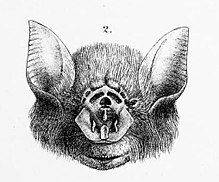
John Edward Gray, FRS was a British zoologist. He was the elder brother of zoologist George Robert Gray and son of the pharmacologist and botanist Samuel Frederick Gray (1766–1828). The standard author abbreviation J.E.Gray is used to indicate this person as the author when citing a botanical name. The same is used for a zoological name.

Mormopterus is a genus of molossid microchiropterans, small flying mammals referred to as free-tailed bats. The genus has been the subject of several revisions, and the diversity of taxa centred on Australia were separated to a new genus Ozimops, and two monotypic genera, Setirostris and Micronomus. The species of Mormopterus, in this stricter sense, are only found in areas outside of Australia and West Papua.

Horseshoe bats are bats in the family Rhinolophidae. In addition to the single living genus, Rhinolophus, which has about 106 species, the extinct genus Palaeonycteris has also been recognized. Horseshoe bats are closely related to the Old World leaf-nosed bats, family Hipposideridae, which have sometimes been included in Rhinolophidae. The horseshoe bats are divided into six subgenera and many species groups. The most recent common ancestor of all horseshoe bats lived 34–40 million years ago, though it is unclear where the geographic roots of the family are, and attempts to determine its biogeography have been indecisive. Their taxonomy is complex, as genetic evidence shows the likely existence of many cryptic species, as well as species recognized as distinct that may have little genetic divergence from previously recognized taxa. They are found in the Old World, mostly in tropical or subtropical areas, including Africa, Asia, Europe, and Oceania.
Wastebasket taxon is a term used by some taxonomists to refer to a taxon that has the sole purpose of classifying organisms that do not fit anywhere else. They are typically defined by either their designated members' often superficial similarity to each other, or their lack of one or more distinct character states or by their not belonging to one or more other taxa. Wastebasket taxa are by definition either paraphyletic or polyphyletic, and are therefore not considered to be valid taxa under strict cladistic rules of taxonomy. The name of a wastebasket taxon may in some cases be retained as the designation of an evolutionary grade, however.

Gould's long-eared bat is a microbat found in southern regions of Australia. It occurs in eastern Australia, from Queensland to Victoria, and in a smaller isolated range in the south-west of Western Australia.
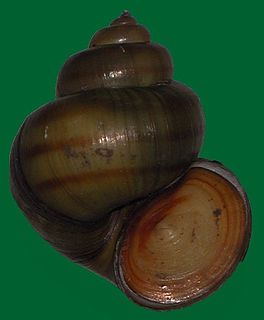
Viviparidae, sometimes known as the river snails or mystery snails, are a family of large operculate freshwater snails, aquatic gastropod mollusks.

The chocolate wattled bat, species Chalinolobus morio, is a bat allied to the family Vespertilionidae. It is found only in Australia, including the island Tasmania, and widespread in southern regions. It is known to reside from sea level to at least 1,570 metres (5,150 ft) in Victoria.
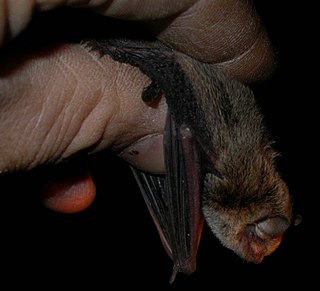
Vespadelus is a genus of bats in the family Vespertilionidae.
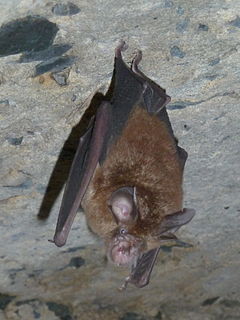
The smaller horseshoe bat is a species of bat in the family Rhinolophidae. It is found in Australia and Papua New Guinea.

The orange leaf-nosed bat is a bat in the family Hipposideridae. It is the only living species in the genus Rhinonicteris which is endemic to Australia, occurring in the far north and north-west of the continent. They roost in caves, eat moths, and are sensitive to human intrusion.
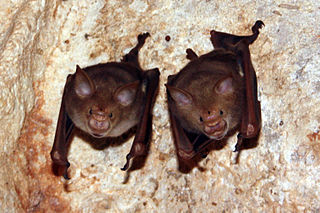
The Hipposideridae are a family of bats commonly known as the Old World leaf-nosed bats. While it has often been seen as a subfamily, Hipposiderinae, of the family Rhinolophidae, it is now more generally classified as its own family. Nevertheless, it is most closely related to Rhinolophidae within the suborder Yinpterochiroptera.
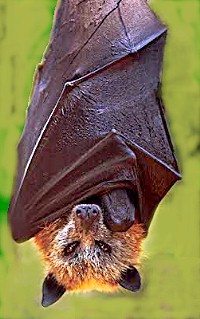
The Yinpterochiroptera is a suborder of the Chiroptera, which includes taxa formerly known as megabats and five of the microbat families: Rhinopomatidae, Rhinolophidae, Hipposideridae, Craseonycteridae, and Megadermatidae. This suborder is primarily based on molecular genetics data. This proposal challenged the traditional view that megabats and microbats form monophyletic groups of bats. Further studies are being conducted, using both molecular and morphological cladistic methodology, to assess its merit.
Brachipposideros is an extinct genus of leaf-nosed bats known from Riversleigh, north-western Queensland, Australia and the Languedoc-Roussillon Region, France. The fossils date to the late Oligocene to early Miocene.

Nyctophilus is a genus of the vespertilionids or vesper bats. They are often termed big-eared bats or long-eared bats, as the length of their ears often greatly exceeds that of the head. This genus occurs in the New Guinean-Australian region.
Macroderma is a genus of microbats, present in the fossil record and as one extant species. They have existed in Australia since the early Miocene.
Rhinonicteris tedfordi is an extinct species of microbat, of the order Chiroptera, known from fossil material found in Australia.
Rhinonycteridae is a family of bats, allied to the suborder Microchiroptera. The type species, the orange nose-leafed species group Rhinonicteris aurantia, is found across the north of Australia.
Riversleigh fauna is the collective term for any species of animal identified in fossil sites located in the Riversleigh World Heritage Area.
Brevipalatus mcculloughi is a species of bat that existed in the early Miocene. It was discovered at a fossil deposit of the Riversleigh World Heritage Area.

Rhinolophoidea is a superfamily of bats. It contains the following families: Craseonycteridae, Hipposideridae, Megadermatidae, Rhinolophidae, Rhinonycteridae, and Rhinopomatidae. It is one of two superfamilies that comprise the suborder Yinpterochiroptera, the other being Pteropodoidea, which only contains the family Pteropodidae.
